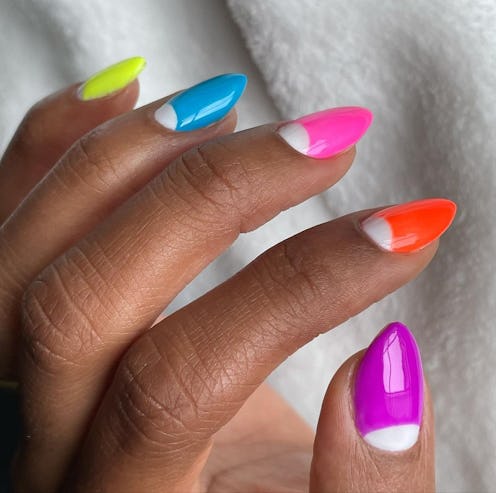Beauty
A Nail Tech Explains How To Safely Remove Acrylics With Acetone & Hot Water
Nail it.
Does anything feel so instantly confidence-boosting as a fresh set of acrylic nails? If you think about it, faux nails might just be the ultimate form of style self-expression — you have ten little go-anywhere canvases in the exact size and shape of your choosing, ready for embellishment, trendy nail polish colors, or full-on tell-the-world messages. On the other hand, though, trying to remove acrylic nails without professional intervention can be tricky at best...and downright disastrous at worst. In a desperate moment, you might even be looking up how to take off acrylic nails with hot water or with household tools. Because the nails are attached to our most-used tools, our hands, when you want those acrylics off, you want them off – immediately, too.
If you’ve ever accidentally ripped, snapped, or broken an acrylic right off (and virtually everyone who’s had fake nails has experienced that scream-worthy pain), you know that improper acrylic nail removal can leave your nail beds damaged, torn, and even bloody, requiring weeks of care and sensitivity to get them fully healed again. To avoid that fate, Bustle turned to Syreeta Aaron, nail professional and LeChat Nails Educator, for an expert’s take on the best way to remove acrylics at home without damaging the delicate nails underneath.
How To Remove Acrylics At Home With Acetone
Before even gathering the materials necessary to safely take your acrylic nails off at home, you’ll first want to assess the polish situation to determine exactly what’s required. If your acrylics are covered in regular nail polish or lacquer, Aaron says you can move right on the soak-off process (more on that in just a sec). But if you have gel polish or powder, you’ll first need to break through that top layer of color. Use a regular nail buffer or file to carefully saw through the topcoat, which will allow the soak to penetrate properly for easier removal. For the soak itself, you’ll want to clip as much of the acrylic tips as you can without touching your real nails, then fully submerge your fingertips in 100 percent pure acetone for around five minutes. Pull them out and start pushing away the gloopy, melted down acrylics with tweezers or an orangewood stick. If necessary, repeat the soak-and-push cycle again.
How To Remove Acrylics Without Acetone
If you can’t get your hands on 100 percent pure acetone, a non-acetone nail polish remover may do the trick, but it’ll take a lot longer — around 40 minutes for the soak. While some “hacks” floating around the internet may claim you can remove acrylics with just hot water, Aaron says in her professional opinion, it’s a non-starter. In fact, she says, the only time she’s seen hot water remove an acrylic is if the natural nail didn’t have bonder or primer on it for very temporary (think one or two days) acrylic wear.
Aaron emphasizes how important it is to take the time to properly remove the acrylics without resorting to the (admittedly very tempting) urge to break, rip, or bite them off manually. “When you choose to tear off the acrylics from the natural nail, you are tearing extra layers off the onyx — onyx being the technical term for nail,” she explains. “Nails are composed of hard keratin, which is technically what skin is made from, so to tear off extra layers would be like tearing off extra skin.” Raw, damaged nail beds are not only painful and sensitive; broken skin can also lead to further inflammation, irritation, or even infection. If all else fails, you can also always go to your nail tech (or any nail tech, really) and ask for an acrylic removal service. It will typically cost you about $10-20, but you’ll have peace of mind – and minimally-impacted nail beds, too.
Acrylic Nails Aftercare
If you don’t plan to immediately follow the removal up with gel polish or more acrylics, Aaron suggests adding a few drops of cuticle oil — like LeChat’s CBD-centric formula — to the bowl for a bit of added nourishment. “By adding cuticle oil to the acetone, it can replenish the natural oils in your nail plate without drying them out with the acetone,” she explains. “However, if you plan to place artificial nail enhancement or gel polish on your nails thereafter, oil is not recommended in the soak-off process.” You can further heal your nails with by using nourishing hand-and-nail cream at night and protecting them from unnecessary harm (aka never using your nails as tools). “Keep in mind that healthy nails are smooth, shiny, and a translucent pink color,” Aaron adds. As for the right time to re-up on a new set of acrylics, Aaron says that’s largely your preference unless your nail tech notices any red flags — things like excessive nail thinning, fungus, or a generally run-down state are all reasons to wait a while. Otherwise, you’re free to go forth and do it all over again.
This article was originally published on
